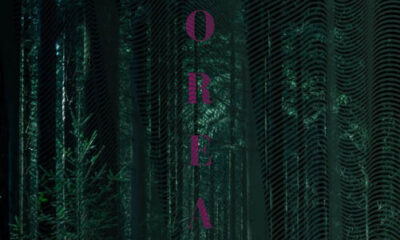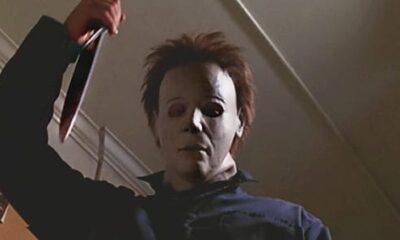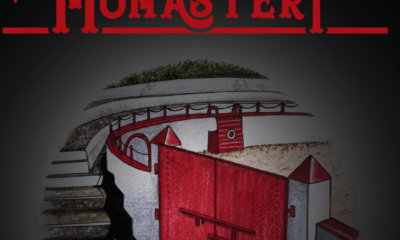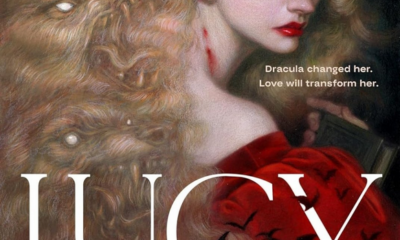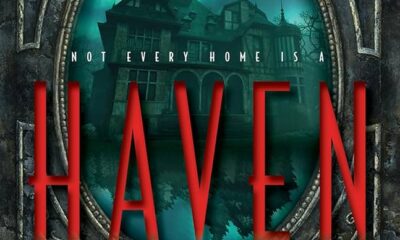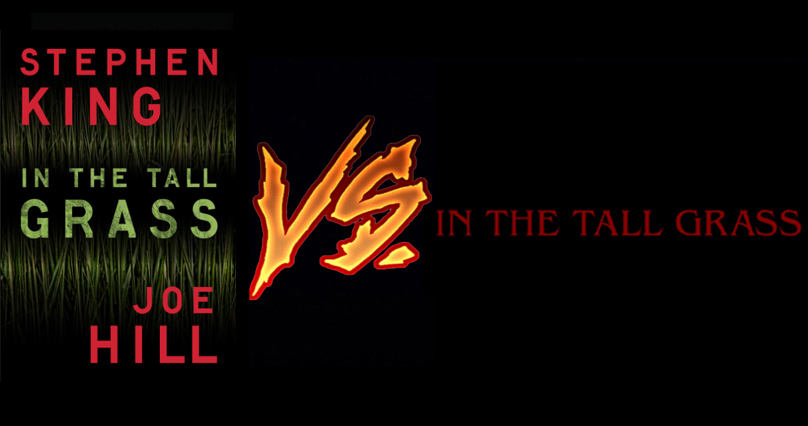
In the Tall Grass VS. In the Tall Grass
There is so much about Stephen King’s and Joe Hill’s In the Tall Grass that I want to know that isn’t answered by either the movie or the book. Normally I might consider that a bad thing, but in this case it lends an air of mystery and suspense to the age old question, “What does a field of grass really want?” In the Tall Grass is a dark tale with a mind-bending slant on other worldly experiences. The amount of scares you get out of the story might depend on your own personal experiences with grasses, but that doesn’t mean it’s not an interesting thing to watch happen to other people, even if you’ve never been frightened of fescue before.
In the Tall Grass – Not even a book. It’s a 70 page short story.
Cal and his nineteen year old sister Becky are on their way cross county to drop off Becky’s still in the oven baby with a new family that wants to adopt it in San Diego. Somewhere just south of Nebraska’s Children of the Corn in Kansas, they get side tracked when they stop and hear a boy calling for help from some tall grass at the side of the road. They apparently didn’t have the common Midwestern knowledge of, you never stop in Kansas. In an effort to help, they enter the grass to try to find the kid and get lost themselves; literally, physically and metaphysically. Needless to say, mistakes were made.
I actually read the book after I first saw the movie hoping it would expand on the story told in the movie, only to find the exact opposite. The book is only really concerned with the characters of Cal and Becky, telling the tale of what happens to them in the grass. The few other characters in the book have clearly nefarious motivations right from the start, and aren’t really given any characterization beyond that. It’s a sordid little story and, while there’s nothing wrong with it, it also doesn’t stand out, especially compared to the movie.
In the Tall Grass – The Movie (or the expanded book edition).
The movie version of In the Tall Grass came out on Netflix in 2019 without much fanfare and was quickly buried by the algorithm after about a month. It’s a pity because it may be one of the truly great Netflix original horror movies on the streaming service. Directed by horror veteran Vincenzo Natali, with a screenplay by King and Natali, the movie builds on the framework of the book to make it what you might call a truly original work of the horror genre.
The story starts approximately the same as the book, Cal and Becky are driving through Kansas when they stop at an abandoned church after hearing a cry for help that draws them into the tall grass. What makes a difference here is being able to really see and hear just how disorienting being lost in the grass is; voices carry in odd ways, the sun seems to change position in the sky, other people will be close one moment then far away the next.
The movie also brings in the new element of the grass distorting time, as well distance and sound. It adds a whole new layer to the story and is actually one of the most interesting aspects of the movie. I won’t give too much away, the journey is really the best part of watching the movie, but because of this time distortion it allows the movie to introduce new characters and locations that weren’t in the book at all. Characters like Becky’s boyfriend Travis, played by Harrison Gilbertson (whom I’ll definitely be looking forward to seeing more of in the future). When Travis enters the movie he almost becomes the main character, and as events unfold he helps lend more backstory and depth to the other characters.
Visually the movie is stunning to look at. Natali manages to make a field of grass truly seem like a living breathing organism. Inventive camera angles and wide shots of people moving though the grass, or even just the grass moving on its own in the wind, lend to the eerie and ominous atmosphere of the film. And credit where credit is due to the film’s concept art designer, manga artist Shintaro Kago for making grass seem threating in a variety of ways. Extreme closeups are used often to great effect to give a visceral feeling to feet squelching in hot mud, the fall of dirt on a dead bird’s body, sweat dripping down a face, or the relief of cool rain drops on a blade of grass.
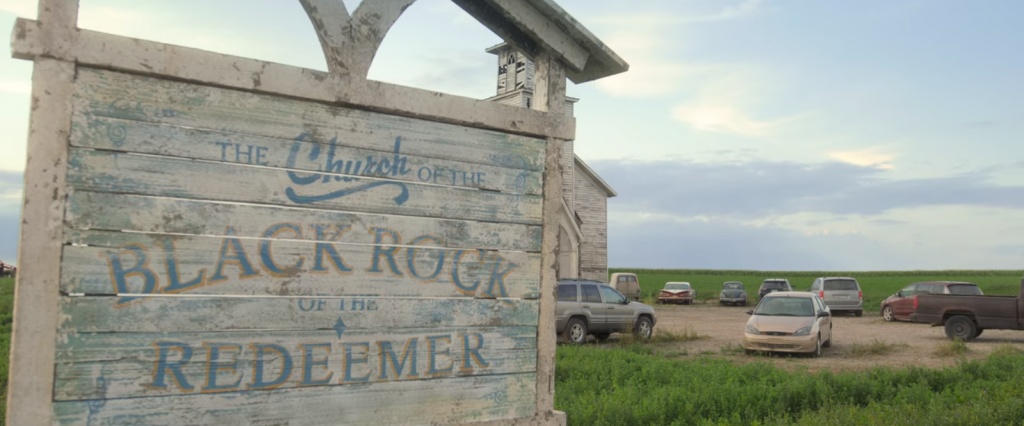
There’s so much they did right in this movie you can certainly forgive the one or two overuses of CGI here and there, and the fact it was filmed in Canada instead of Kansas. I don’t even think I’ve mentioned the acting yet, which is spot on by everyone in the cast. If you can’t tell, I thought this movie was one of the best of 2019, and I LOVED US and The Lighthouse (2019 pretty much rocked the horror movies in general).
Final Girl Thoughts
In the Tall Grass the book may be a bit lacking, but the movie blew away all my expectations for what a Netflix original horror movie could be. Under Natali’s expert direction it may be one of Stepehen King’s scariest horror movies in a long time. Clearly I think it’s worth watching and rewatching around the time the grass starts getting greener outside. I would watch any number of prequels and sequels about this dimensional patch of grass in Kansas with a black rock in the middle of it because it clearly has more stories to tell. How did the grass fare during The Dust Bowl? Were Cal and Becky really chosen or was it just dumb bad luck they stopped? And how does the grass affect your game if you’re bowling at the bowling alley across the street from the Church of the Black Rock of the Redeemer? These are all important questions that still need answers.
 (5 / 5)
(5 / 5)
Book Reviews
A Stellar Debut Novel, We Used To Live Here
Imagine this. You’re home alone, waiting for your partner to return, when you hear a knock on your door. You answer it to see a family of five, bundled up against the cold. The father, a kindly older gentleman, explains that he used to live in this house as a boy. And he would love to show it to his family.
Do not let them in.
The story
Released in June 2024, We Used To Live Here is author Marcus Kliewer’s debut novel. It tells the story of Eve, who just purchased a beautiful house with her partner, Charlie. Their plan is to flip the house and sell it.
One night, while waiting for Charlie to come home, Eve is surprised by a knock at the door. It’s a man named Thomas Faust and his family.
Thomas explains that he grew up in the house and hasn’t been in the area in years. Would Eve let them in so that he can show the home to his children?
Against her better judgment, Eve lets them in. She regrets this almost at once when Thomas’s daughter vanishes somewhere into the house.
What worked
I always appreciate a book that allows you to play along with the mystery. And this book does that better than just about any other I’ve seen.
Pay close attention to the chapters, to the words that aren’t there. To everything about this novel.
This is mostly down to Kliewer. This is ultimately his work of art. But the production value is also fantastic. I don’t want to ruin the multiple mysteries, so I’ll just say this. There are clues in this book that require some specific artistic choices in the page layouts in this book. And I loved that.
If you’d like to experience another horror book review, check out this one.
We Used To Live Here is also the kind of story that makes you question everything right along with the main character, Eve. Eve is a great main character. But she might be an unreliable narrator. She might be experiencing every single horror described, exactly as it’s described. Or, she might be having a psychotic breakdown. Through most of the book, we can’t be sure. And that is so much fun.
Finally, the weather plays a large part in this story. There are several stories in which the weather or the land itself could be considered a character. Even an antagonist. This is certainly one. The winter storm is the thing that traps the family in the house with Eve. It also makes escaping the home difficult. Reading this book during the winter was especially impactful. Most of us know what it feels like to be shut in by a storm. I’ve personally lived through some of those storms that are just referred to by their year, as though they were impactful enough to claim the whole 365 days for themself. And that was with people I liked. Imagine what it would feel like with strangers. It’s a staggering thought and one that we explore in depth in this book.
In the end, We Used To Live Here is a fantastic book. It’s the sort of story that sneaks into your brain and puts down roots. And if this is just the first book we’re getting from Kliewer, I can’t wait to see what else he comes up with.
 (5 / 5)
(5 / 5)
Book Reviews
Exploring real terror with The House of My Mother
As a disclaimer, this is a review of The House of My Mother from a critical perspective. I will not be discussing my opinions of the legal case against Ruby Franke and Jody Hildebrandt. I will be discussing the merits of the book as a work of true crime alone.
In 2015, Ruby Franke started a YouTube channel called 8 Passengers. In August of 2023, Franke and her business associate Jodi Hildebrandt were arrested for, and later plead guilty to, charges of aggravated child abuse. And in January of this year, Shari Franke told her story in The House of My Mother.
The story
The House of My Mother is the true story of Shari Franke, the oldest child of one of the most famous family vlogger families.
As a child, Shari came to the conclusion that her mother didn’t like her. Soon, she began to fear her mother’s anger.
Things got significantly worse when Ruby started their family vlog. All of the families most intimate moments were splashed across the internet for anyone to watch. This became a living nightmare for Shari.
Of course, that was only the start of the family nightmare. Because Ruby was about to meet someone who would reinforce all of the darkest parts of herself.
Eventually Shari manages to escape her home. But her younger siblings were still in her mother’s clutches. She had to save them, and her father, from the monster her mother had become.
What worked
Through the book, Shari only ever mentions the name of one of her siblings, Chad. This is because Chad is the only of her siblings that is an adult at the time of the publication.
There are children involved in this story. Children who’s lives and privacy have already been damaged. Shari didn’t want to do that to them again, and neither do I.
It probably won’t surprise you that this book is full of upsetting details. But not in the way you might imagine.
Nowhere in this book will you find gory details about the abuse the Franke kids suffered. And I consider that a good thing. Those sort of details are all fun and games when we’re talking fiction. When it’s real kids who are really living with the damage, it’s not a good time.
What you’ll find instead is a slew of more emotionally devastating moments. One that stuck with me is when Ruby’s mother gives her a pair of silk pajamas as a gift after Ruby gave birth to one of her babies. Shari asks Ruby if she’d bring her silk pajamas when she had a baby. Ruby responds that yes, when Shari becomes a mother they can be friends.
What a lovely way to make a little girl feel like she’s not worth anything unless she reproduces. And, if she does decide to have children, who is going to bring her silk pajamas?
In the end, this isn’t a story about ghosts or demons. It’s not about a serial killer waiting on a playground or in the attic of an unsuspecting family. Instead, this is a story about things that really keep us up at night. It’s the story of a woman so obsessed with perfection that she drove away her eldest daughter. The story of a young woman who’s forced to watch from afar as her beloved brothers and sisters are terrorized and abandoned. These are the sorts of things that really keep us up at night. These are the real nightmares.
More than that, though, The House of My Mother is a story of survival. It’s about a family that was ripped apart and somehow managed to stitch itself back together again. It’s about a brave young woman who managed to keep herself safe and sane in the face of a nightmare. If you haven’t read it yet, I can’t recommend it enough.
For more like this, check out my review of Shiny Happy People.
 (5 / 5)
(5 / 5)
Book Reviews
Book Review of Boreal: an Anthology of Taiga Horror
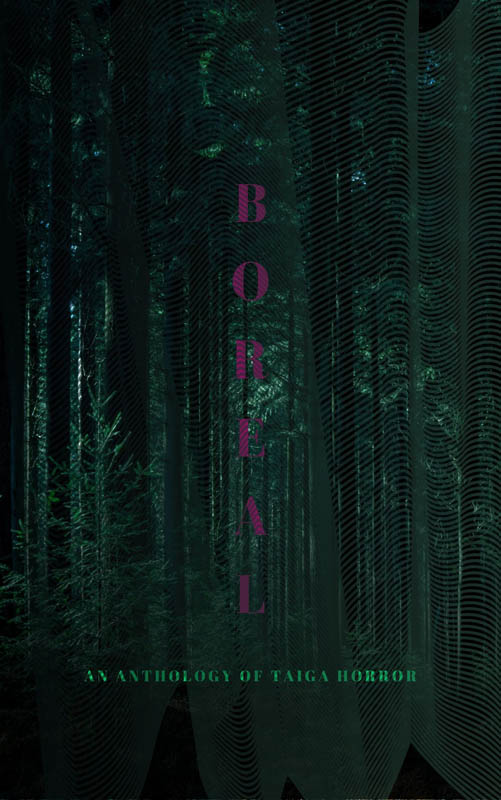
Boreal: an Anthology of Taiga Horror is a collection of twenty-two haunting tales that dwell in the deepest darkest woods and frozen wastelands, edited by Katherine Silva and including Haunted MTL’s very own Daphne Fauber. Each story has even been gifted with its very own poster, hinting at the horrors to be found within it, bestowing a beautiful visual collection as well.
The tales are varied and touch upon the environment in new and different ways, each hearkening to a sort of epiphany or raised awareness. These stories exude both dread and wonder at the smallness of our human existence in contrast to the sacred world we have isolated from, sheltering ourselves in our comfortable houses with centralized heat and everything we could possibly need or want at the ready. The taiga becomes a sanctuary outside of our own dulled awarenesses. It is a holy place imbued with powers beyond mortal human reach, a wilderness that threatens to swallow us – both whole and bit by bit, simultaneously.
The protagonists enter into this realm through ritual, superstition, longing, stubbornness, and their own hubris – yearning to survive its dangers, and to make their own marks upon it. The starkness of their surroundings harbors delicate moments that would be all too easily missed if not deliberately sought or pointed out. The softness of fur, the dappled sunlight shining through trees, the hazy clouds of breath forming in crisp air, the brittleness of bleached bone… those quiet experiences that beg to be forgotten, to lay safely sleeping just below the frozen surface, awaiting spring.
There are those who followed in the footsteps of their predecessors, seeking to escape the constraints of their parent’s and elders’ indoctrination, traditions, madness, and abuse, yearning to find their own way despite also being inextricably bound to their own pasts. There are those who just wanted to go for a walk in the woods, and remained forever changed by what they experienced. There are those who wished to impose their will upon the wilderness, their order falling to disarray, unable to make lasting impact. There are those who sought to leave behind the world of mankind, looking for oneness in the natural order of things through isolation, leaving a bit of themselves behind after being consumed by the terrors they encountered. There are those who truly found communion with the woods, became one with its wildness, and invited its spirit into their hearts to find peace, even at cost of their own lives. And then, there are the spirits themselves…
 (3 / 5)
(3 / 5)
All in all, I give Boreal: an Anthology of Taiga Horror 3.0 Cthulhus. I love existential angst so I found it to be an enjoyable read, and I appreciated the myriad manners in which the biome was explored. But there were points in which I found myself struggling to follow along, as if the words were swept up into their own wilds in ways that alienated myself as reader, as if my mere voyeurism into this otherworldly place was not enough to comprehend the subtle deviations in storytelling mannerisms fully. I suppose in some sense this seems appropriate, but at the same time, it left me feeling a bit unfulfilled, as if I had missed a spiritual connection that should have resonated more deeply.


